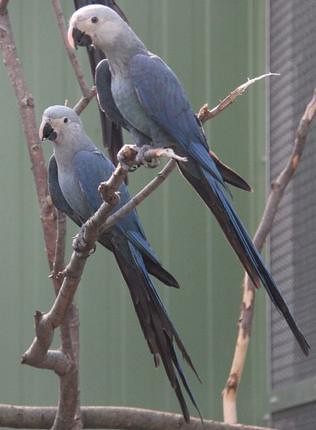 The last known Spix's macaw in the wild disappeared in 2000, and now 93 birds of this species exist in breeding centres around the globe. Image by ACTPA pair of Spix’s macaws, captive-bred in Germany, could be released into their natural habitat in Brazil by 2021
The last known Spix's macaw in the wild disappeared in 2000, and now 93 birds of this species exist in breeding centres around the globe. Image by ACTPA pair of Spix’s macaws, captive-bred in Germany, could be released into their natural habitat in Brazil by 2021
If Rio 2 provided a macaw’s eye view of the world, this is the story of two extremely endangered real life Spix’s macaws — which are extinct in the wild — ready to make their way to their Brazilian habitat in the not too distant future, thanks to a conservation programme.
Carla and Tiago, two Spix’s macaws hatched at the breeding centre at Schöneiche, in Brandenburg, Germany, and named after the film’s heroes, have been flown to Sao Paulo from Berlin. They will be reared at a special facility till they are ready for release into a suitable area in northeast Brazil by 2021.
The Association for the Conservation of Threatened Parrots (ACTP) achieved the breeding success last April, and transported the two Spix’s macaws on March 3 as a World Wildlife Day gift to the Brazilian government.
ACTP curator Enrico Sydow said in a press release: “The two remained very cool during the entire flight. They sat together in the cabin with their caretakers in their transport box. Parrots are very intelligent and curious.” The programme was aided by the German Federal Agency for Nature Conservation.
There are ten Spix’s macaws in Brazil, only two of them male. The global breeding programme for these iconic blue birds in Schöneiche, Qatar and Brazil record a total population of 93, of which 53 are female.
Described by some as the world’s rarest birds, wild populations of these macaws dwindled and disappeared largely due to trapping for the bird trade.
Johann Baptist von Spix, a German naturalist, described the Spix’s macaw, after capturing a wild specimen on the banks of the Sao Francisco river around 1819, as a bird that lived in flocks and had a thin voice.
Spix, however, thought it to be a variant of the hyacinth macaw and only after his death was the blue parrot recognised as a distinct species by his assistant, zoologist Johann Wagler, and it was given the nomenclature Cyanopsitta spixii.